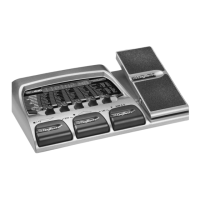FBACK (Feedback) - Expression Pedal controls the amount of Delay Feedback.
DLYLVL (Delay Level) - Expression Pedal controls the Mix Level of the selected Delay Type.
DECAY (Decay) - Expression Pedal controls the length of Reverbs Decay time.
REVLVL (Reverb Level) - Expression Pedal controls the Reverbs Mix Level.
VOLPRE (Volume Pre) - Expression Pedal controls the Volume after the Amp Modeling but before the
Effects.
VOLPST (Volume Post) - Expression Pedal controls the Volume at the end of the Effects chain.
V-Switch
The RPx400’s Expression Pedal includes DigiTech’s exclusive V-Switch. The V-Switch allows the
Expression Pedal assignment to be switched on the fly. Applying extra pressure to the toe of the
Expression Pedal will engage the V-Switch and the function of the Expression Pedal will switch
between the assigned parameter and Wah. The sensitivity or amount of pressure required to engage
the V-Switch can be adjusted to suit your personal taste (or weight of your foot). See page 36 for the
V-Switch Sensitivity adjustment procedure.
LFO
The RPx400 includes two assignable low frequency oscillators (LFO TR and LFO SQ) which can be
assigned to any of the same parameters available for assignment to the Expression Pedal. A low fre-
quency oscillator will automatically vary the value of the assigned parameter at a steady rate. A mini-
mum and maximum value each LFO will reach may be also be assigned. For instance; if the Amp Gain
was assigned to
LFO TR, and the minimum value was set at 1 and the maximum value was set at 99,
the RPx400 would automatically sweep the amount of distortion from a clean sound to a distorted
sound. Individual LFO speeds are also available for assignment. In the previous example, the LFO
speed would determine the length of time it took the LFO to sweep from the clean to the distorted
sound. LFO TR oscillates using a triangle waveform and
LFO SQ uses a square waveform. The proce-
dure for assigning the LFOs in the RPx400 is as follows:
1. Press the Select button until the Expression row has been selected (indicated by the LED lighting
on the Expression row).
2. Rotate the Number 1 Knob to select whether you want to assign LFO TR (
LFO TR) or LFO SQ
(
LFO SQ).
3. Rotate the Number 2 Knob until the desired parameter appears in the display.
4. Rotate the Number 3 Knob to select the minimum value the assigned parameter will reach at the
bottom turn around point for the LFO (not available when volume is the assigned parameter).
5. Rotate the Number 4 Knob to select the maximum value the assigned parameter will reach at the
top turn around point for the LFO (not available when volume is the assigned parameter).
6. Rotate the Number 5 Knob to select the speed at which the LFO will oscillate from the minimum
to the maximum value.
7. Store your LFO assignment to your Preset. See page 9 for more information on the storing proce-
dure.
21
Creating Presets

